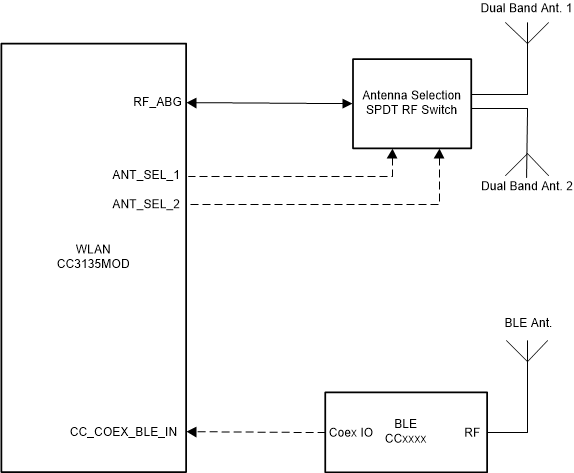SWRS225D February 2019 – May 2021 CC3135MOD
PRODUCTION DATA
- 1 Features
- 2 Applications
- 3 Description
- 4 Functional Block Diagrams
- 5 Revision History
- 6 Device Comparison
- 7 Terminal Configuration and Functions
-
8 Specifications
- 8.1 Absolute Maximum Ratings
- 8.2 ESD Ratings
- 8.3 Recommended Operating Conditions
- 8.4 Current Consumption Summary: 2.4 GHz RF Band
- 8.5 Current Consumption Summary: 5 GHz RF Band
- 8.6 TX Power Control for 2.4 GHz Band
- 8.7 TX Power Control for 5 GHz Band
- 8.8 Brownout and Blackout Conditions
- 8.9 Electrical Characteristics for DIO Pins
- 8.10 WLAN Receiver Characteristics
- 8.11 WLAN Transmitter Characteristics
- 8.12 BLE and WLAN Coexistence Requirements
- 8.13 Reset Requirement
- 8.14 Thermal Resistance Characteristics for MOB Package
- 8.15 Timing and Switching Characteristics
- 8.16 External Interfaces
- 9 Detailed Description
- 10Applications, Implementation, and Layout
- 11Environmental Requirements and SMT Specifications
- 12Device and Documentation Support
- 13Mechanical, Packaging, and Orderable Information
Package Options
Mechanical Data (Package|Pins)
- MOB|63
Thermal pad, mechanical data (Package|Pins)
10.1.2 Antenna Selection
The CC3135MOD device is designed to also support antenna selection and is controlled from Image Creator. When enabled, there are 3 options possible options:
- ANT 1: When selected, the GPIOs that are defined for antenna selection with set the RF path for antenna 1.
- ANT 2: When selected, the GPIOs that are defined for antenna selection will set the RF path for antenna 2.
- Autoselect: When selected, during a scan and prior to connecting to an AP, CC3135MOD device will determine the best RF path and select the appropriate antenna (12)(13). The result is the saved as port of the profile.
Figure 10-2 shows the antenna selection implementation for Wi-Fi, with BLE operating on it's own antenna. Note in this implementation, only a single GPIO from the BLE device to the CC3135MOD device is required. The Antenna switch (14)is controlled by 2 GPIO lines from the CC3135MOD device. Table 7-2 lists which GPIOs can be used for Antenna Selection.
 Figure 10-2 Coexistence Solution with
Wi-Fi Antenna Selection and dedicated BLE antenna
Figure 10-2 Coexistence Solution with
Wi-Fi Antenna Selection and dedicated BLE antenna12. When selecting
Autoselect via the API, a reset is required in order for the CC3135MOD
device to determine the best antenna for use.
13. Refer to the Uniflash with Image Creator User
Guidefor more information.
14. The
recommended Antenna switch is the Richwave RTC6608OSP.